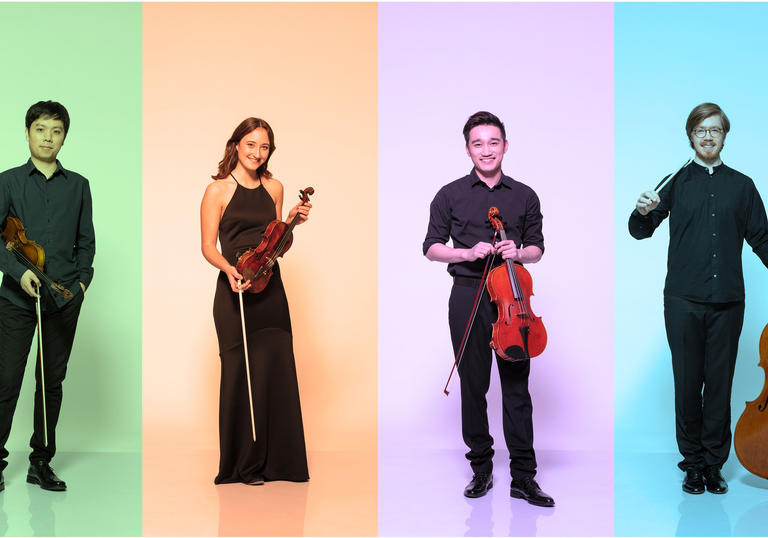Second violinist Antonia Rankersberger explains: ‘As a genre, string quartet music is very versatile and complex, and we like the idea of keeping it as simple as possible, to concentrate and focus on the music and not add anything unnecessary.’ Their title was actually chosen very quickly when the original founders needed a name to apply for a competition when they were starting out in 2008, and across the road they saw the Simply Thai restaurant. Maybe serendipity was at work.
Anton Webern (1883–1945) wrote his first catalogued work for string quartet, Five Movements for String Quartet Op 5, in 1909, a year after his teacher Arnold Schoenberg had introduced atonal music to the string quartet form with his Second String Quartet, moving beyond conventional harmonic structures. Webern’s piece is also atonal and may seem hard to grasp initially, but its ten minutes reward intense attention, as Rankersberger describes: ‘If you listen closely, you hear how everything is concentrated to a core.’
Perhaps the best way to approach it is with the openness of a child. Rankersberger says, ‘We sometimes play this piece at children’s concerts, asking them to close their eyes, listen, and think of a story. It is amazing what they come up with. One child said that at the beginning, he was walking around in a big city with a lot of people, and it very stressful and he felt insecure, but in the end, he met a person whom he felt he could trust, and he felt safe again. It was beautiful to hear his story.’
It can be harder for adults to access this innocence, though, she admits: ‘I am intimidated by modern music myself, sometimes. As adults we go to a concert and someone asks us what we think about it, and we don’t immediately consider what we felt or what the music gave us. We think we need to show some sort of expertise or see complex structures and talk about it in an intellectual way. That takes away an honest approach and the spontaneous view that music can give us. We should try to listen to music as if we were children.’
For the players, the challenge is to create the different sound worlds that Webern specifies: ‘We have to change our technique very quickly to get the contrasts. In the first movement there is a lot of col legno, where we play with the wood of the bow on the string. Webern uses very precise distinctions in his dynamic markings, for example between the way he describes the piano – at one place it is p and then suddenly changes to ppp, and then it’s pp again. We have to make these differences very carefully, which demands a variety of bow techniques.’
The second piece on the programme, Julia Lacherstorfer’s un:fold, offers a complete contrast, in that it is based on folk tunes – and not just any folk tunes. The work was written specially for the quartet and as part of the ECHO commissioning process, Lacherstorfer met the four of them and asked them lots of questions. Rankersberger remembers, ‘We went to see her in a folk music basement venue, and she asked us about our childhoods – what colours and moods we remembered, and how we felt. We all had different answers, because Xiang and Danfeng are from China and Ivan and I are from Europe. She asked each of us if we could play a little melody that reminds us of our childhood and where we grew up, so we all brought her our own folk music tunes.’
Lacherstorfer has fed these folk tunes into her music, with each player represented by their own movement. Rankersberger chose the Austrian tune ‘Wann du durchgehst durchs Tal’ (When you walk through the valley), which she used to sing with her grandmother. ‘The title un:fold is because with each movement, you get to know us better as a group and as individuals. It’s a really intimate and private moment to share with the audience, and it’s nice to tour something that is so personal.’
Bartók began his Sixth String Quartet in August 1939, a month before the Second World War broke out, and had finished it by November. Each of its four movements begins with a ‘mesto’ – a slow, sad melody, reflecting the mood in which Bartók was at the time. Rankersberger says, ‘Bartók wrote it during the outbreak of World War II, just after his mother died and he had to move to the US, and everything was difficult for him. The first movement starts with a viola solo in the mesto, and with each movement, more of us play the mesto, until in the end we all play the mesto together. The movements are very contrasting. For example, the second movement is a Marcia, with a marching rhythm underpinning everything, whereas the third movement is a burletta, which is grotesque and exaggerated gestures. Altogether, the work very colourful and special.’
The audience goes on a journey during the hour of the concert, as Rankersberger describes: ‘It’s interesting to start with the Webern because you immediately catch the audience’s attention and everyone has to be really present. Julia’s piece is traditional and gives us the chance to present ourselves. We close with the Bartók, which requires some concentration. It may not be the easiest programme to listen to, but it’s worth the effort to experience as many colours as possible.’
© Ariane Todes

